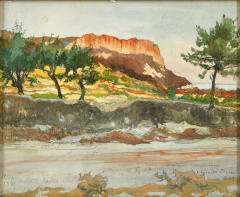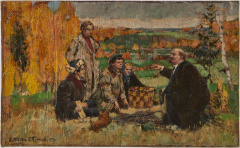Graphics by Klimt and Schiele at the Pushkin Museum
Today in the Pushkin Museum. A. S. Pushkin opens exhibition of graphic works of the leading representatives of Austrian art of the early XX century Gustav Klimt (1862-1918) and Egon Schiele (1890-1918).
Selected for the exhibition works belong to different periods of creativity of artists and represent different types of drawing – studies of figures, associated with paintings, portraits, self-studies of a female Nude models, etc. Using traditional graphic techniques — black chalk, graphite pencil, watercolor, gouache, — artists have decided a new aesthetic challenges facing them at the turn of XIX and XX centuries.
Gustav Klimt, the main representative of Viennese art Nouveau, had the reputation of being a phenomenal painter who has secured a very special place not only in Austrian, but in the art world. His drawings have influenced the work of younger artists in the first place — Egon Schiele, who began his career at a time when Klimt had already reached the peak of their creativity. Acquired experience of its predecessor, awl very early developed its own unique style, which marked the transition from art Nouveau to expressionism.
the works of Gustav Klimt and Egon Schiele at the Albertina appeared during the life of the artists. For a hundred years the number of Klimt drawings in the Museum's collection has reached 170, and Schiele — 140; add to this about 40 sheets received in albertino for long-term storage.
Klimt Drawings enjoyed great popularity among connoisseurs of art and collectors in the years immediately before and after his death (the artist died in 1918). Over time, Klimt-рисовальщик was in the shadow of Klimt-живописца, but in our days the study of his graphic heritage allowed to fully evaluate the role of drawing in his work. After the death of Klimt in his Studio there are about 2 500 drawings — that were not themselves sold, given away or destroyed. All in all, present, there are over 4,000 drawings by the artist.
a Significant part of the Klimt drawings associated with a particular painting masters. The artist almost never spoken about his creative intentions, either orally or in writing. It figures allow us to understand his method of working, the process of creating paintings or murals. Klimt devoted much attention to the preparatory etudes for each piece, in its picturesque multi-figure compositions. Sometimes there is a whole series dedicated to the same cause or position.
a larger category of drawings in the exhibition are studies for portraits of women (portrait of Serena Lederer, Paula, Zuckerkandl, etc.). In these preparatory works, Klimt sought to find a model's pose and composition of the portrait as a whole, which will best Express the personality portrayed through the prism of perception of the artist.
Klimtrevolutionized the image of female nudity. In a candid interpretation of eroticism in his drawings went much further than in painting. Some studies of this kind have arisen in connection with the work of Klimt above the picturesque compositions, but most of them has an Autonomous character ("Reclining Nude").
the Graphic style of Klimt underwent changes throughout his life. Early drawings demonstrate a thorough academic training school;, they differ in almost photographic detail. But they are already to be seen what will become a constant graphic style of Klimt, — the primacy of the linear beginning, the expressiveness of the circuit, in which the accuracy combined with sensuality. A separate page in the legacy of Klimt comprise the illustrations for the magazine "Ver Sacrum" (1898), built on contrasts of black and white ("Cap D"); can be considered the reference samples of the art Nouveau style in the chart. Over time, his work is enhanced by the element of stylization and geometrization of forms.
Approximately 1897 Klimt painted in black chalk on sheets of brown wrapping paper, and later, circa 1903-1904 began to use more smooth Japanese paper combined with graphite pencil ("Sitting half-naked"). Hard and fine lines of graphite, traces of which have a slight metallic luster, determine the nature of drawings that chronologically correspond to the "Golden style" of painting ("Standing Nude, pregnant"). In subsequent years (after 1908 and especially after 1910) in the drawings of Klimt planned change in the direction of greater freedom and more freedom and "picturesque", lines that sometimes become intermittent and nervous that convey the inner emotion of the artist ("Standing with his hands down").
Drawing style of Klimt based on expressive contour line, became a model for Egon Schiele. Experience decorative stylization of nature, the accumulated Viennese modernity, was reinterpreted and applied to the solution of new tasks set by the aesthetics of expressionism.
Schiele Himself considered himself primarily a painter and wanted as such it is perceived. However, in the eyes of many critics and art lovers Schiele-рисовальщик often overshadows Schiele-живописца. Line and contour play such a significant role in the painting of Schiele, the picture may be considered as the basis of his paintings. He left behind about 3,000 works on paper — drawings, watercolors, gouaches.
Presented in the exposition of the earliest drawings Schiele relating to 1906 ("Self", "Bust of Voltaire"), define the reference point, allowing to estimate the rapid evolution that has undergone his work in subsequent years. A series of sketches of postcards (circa 1909) shows that by the time the artist has already mastered the style of the secession and the Wiener werkstätte, which had a decorative and geometric stylization; in this period he was under strongthe influence of Gustav Klimt.
But since the second half of 1909, Schiele gradually freed from this influence; in 1910, he finally finds his own original style. In place of decoration and elegance come expression and emotional tension ("the Painter Max Oppenheimer"). Expressive contour becomes the main means of expression in the drawings of Schiele. The transition from art Nouveau to expressionism was marked by the denial of "beauty" in the interpretation of idealistic aesthetics; it meant a blurring of the boundaries between the beautiful and the ugly. The limits of art are expanding, it absorbs what used to be considered anti-aesthetic ("Sideshadowing"). In his watercolors and gouaches Schiele uses color to enhance the emotional impact of the work. Some works of 1913 and 1914 bar becomes angular and "spiky".
over the next years (1915-1917) in the drawings of Schiele, there is a growing tendency to realism, to the transfer volume, and plastics ("Nude, lying on the belly"). In the drawings, 1918 cultivated continuous contour line outlining the entire figure, — pure contour, only sometimes in some places supplemented by sparse hatching. The awl reaches the unerring precision of the lines, conciseness and economy of pictorial means ("Reclining Nude with crossed legs").
 Egon SCHIELE self-Portrait in the Nude, a grimace. 1910
Egon SCHIELE self-Portrait in the Nude, a grimace. 1910
pencil, charcoal, gouache and opaque white on brown paper
© Albertina, Wien bzw
© The Albertina Museum, Vienna
Source: arts-museum.ru Egon SCHIELE Seated couple. 1915
Egon SCHIELE Seated couple. 1915
pencil, watercolor and gouache on paper
© Albertina, Wien bzw
© The Albertina Museum, Vienna
Source: arts-museum.ru
In the period around 1910-1911 years Schiele often drew children — their images are among the first expressionist works Schiele ("the Girl in Buffy-желтом dress"). In the legacy of Schiele-рисовальщика many portraits@the semicolon very often it is people of his "inner circle."
a very special phenomenon in the history of art — numerous self-portraits Schiele. The artist creates different images of himself, trying on masks, playing roles, grimacing; in some self-portraits, he depicts himself naked. All this — visual symbols of the fragility of the "I", divided into incompatible parts. Schiele attached great importance to the expressive gestures, postures and facial expressions — as its own (self-portraits) and their characters. The body language from Schiele invented and staged by him; poses of the models are not the natural expression of real emotions, and dictated by the artist ("self-Portrait in the Nude, grimace").
a Significant part of Schiele's work on paper dedicated to female models, often Nude. Like Rodin and Klimt, he painted women in his Studio, watching their behavior. For Schiele was not bans the depiction of women. All taboos were lifted. Full disclosure-in the treatment of erotic motifs were elevated to an aesthetic principle ("Salamatina").
the Figures in the drawings Schiele torn from the social and personal context, is placed in the abstract field of the sheet where there-либо benchmarks; the characters exist outside of time and space.
In the legacy of Schiele-рисовальщикаoccupy a very special place thirteen watercolours and drawings made during his imprisonment in the spring of 1912, which he experienced as an insulting infringement on their freedom; of them at the exhibition shows two sheets ("Outer door", "My way lies over the abyss"), having the character of an authentic documentary evidence.
Vitaly Mishin, curator of the exhibition: "I Think for many Russian viewers of this exhibition will be opening new aesthetic horizons. She expands the usual understanding of the beauty, expressiveness and, perhaps, even the boundaries of what is permitted in art. In our country, because of different historical circumstances, it is much better to know the Parisian avant-garde early XX century, rather than the artistic life of Vienna “around 1900”. This also applies to the pattern, despite the fact that Gustav Klimt and Egon Schiele long been recognized as one of the most distinguished draftsmen in art history. But to appreciate the pure graphic beauty and powerful energy of these works, they need to see with your own eyes: reproductions in books and on the Internet do not convey even a fraction of the artistic qualities of the paintings by these great Austrian masters. The exhibition halls of the Pushkin Museum based on the rich collection of the Albertina will give us such a rare opportunity will allow a deeper understanding of the evolution of creativity of both artists, the artistic method and the unique aesthetic world of each of them."
the curators of the project: Vitaly Mishin (leading researcher of the Department of art of Europe and America XIX–XX centuries, the Pushkin Museum im. A. S. Pushkin) and Christof Metzger (Albertina, Vienna)
Recommended age 18 .
Source: arts-museum.ru
Permanent link to:
https://artinvestment.ru/en/news/exhibitions/20171010_klimt_schiele_exhibition_in_gmii.html
https://artinvestment.ru/news/exhibitions/20171010_klimt_schiele_exhibition_in_gmii.html
© artinvestment.ru, 2024
Attention! All materials of the site and database of auction results ARTinvestment.RU, including illustrated reference information about the works sold at auctions, are intended for use exclusively for informational, scientific, educational and cultural purposes in accordance with Art. 1274 of the Civil Code. Use for commercial purposes or in violation of the rules established by the Civil Code of the Russian Federation is not allowed. ARTinvestment.RU is not responsible for the content of materials submitted by third parties. In case of violation of the rights of third parties, the site administration reserves the right to remove them from the site and from the database on the basis of an application from an authorized body.








